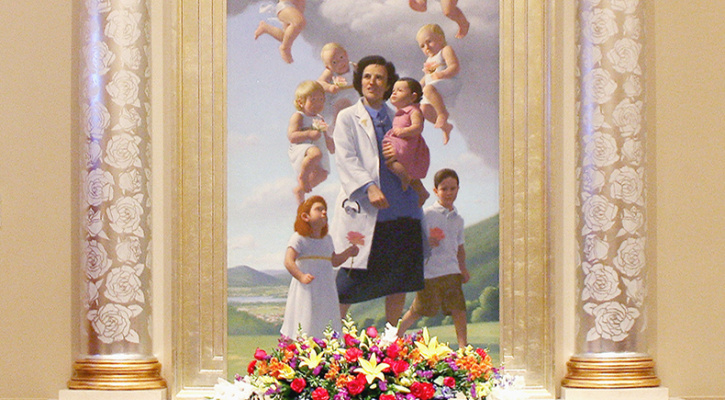Archdiocese of New Orleans Develops Program to Help Parents Combat Pornography ‘Epidemic’, by Della Hasselle

Spokane’s Bishop Daly Talks to the Inlander About Gay Priests, Sex Abuse and That Abortion Letter, by Daniel Walters
March 12, 2019
Reflections on the 1st Week of Lent: Breakfast in the Desert
March 12, 2019
Archbishop Gregory Aymond invites people to join in for the grave blessing during All Saints Day Mass at Our Lady of the Rosary Catholic Church in New Orleans, Thursday, Nov. 1, 2018. Advocate Staff photo by SOPHIA GERMER
By Della Hasselle, The New Orleans Advocate, March 9, 2019
 When Archbishop Gregory Aymond heard three stories in one week about children and adults in the New Orleans archdiocese becoming addicted to pornography, he decided to take action.
When Archbishop Gregory Aymond heard three stories in one week about children and adults in the New Orleans archdiocese becoming addicted to pornography, he decided to take action.
He assembled a team to develop a plan to give Catholic clergy, families and schools the tools to help them talk about the “elephant in the room,” according to David Dawson, director of the archdiocese’s Office of Marriage and Family Life.
A year ago, the archdiocese held its first “Safe Haven Sunday,” a campaign that focuses on helping families navigate what the church is calling a pornography “epidemic.”
This year, the effort has grown, with 20 additional dioceses using the program to educate parents, schools and clergy about how to minimize accidental exposure to porn and what to do if children and adults become addicted to it.
The program entails a focus session during Sunday Mass, free booklets for parishioners, a website with information about pornography addiction, talks at Catholic schools and counseling sessions.
Aymond’s efforts build on an existing partnership between law enforcement and local public, private and Catholic schools that focuses on internet safety as pornography and even more dangerous sites — including those involving sexual traffickers and other predators — become easier to access.
According to the National Center on Sexual Exploitation, pornography was estimated to be a $97 billion global industry by the end of last year, with about $12 billion of that coming from the U.S.
Links to pornography have become increasingly easy to find on mainstream sites like YouTube and Instagram, experts say, and in recent years, porn sites have received more regular traffic than Netflix, Amazon and Twitter combined.
And, as kids often get accidental access via a pop-up ad or typo, its users are becoming younger, researchers have found.
While the average child’s first exposure to pornography occurs at age 10, studies show about 64 percent of young people ages 13 to 24 actively seek out pornography weekly or more often.
For some, the exposure can have negative consequences, according to the anti-porn organization Fight The New Drug. Studies have found that frequent porn use correlates with depression, anxiety, stress and social problems, and that exposure can also increase aggressive behavior.
The Department of Justice and the National Center for Missing and Exploited Children have also linked pornography to sex trafficking.
“No one person has a silver bullet to solve the problem, because that’s how large it is,” said Timmy McCaffrey, director of the archdiocese’s Catholic Youth and Young Adult Ministry Office. “So we came together to come up with ideas.”
The program is a local response to a document issued in 2015 by the United States Conference of Catholic Bishops called “Create in Me a Clean Heart: A Pastoral Response to Pornography,” which acted as a guide for Catholic leaders seeking to address the issue.
For years, the FBI has sought to provide information to schoolchildren about internet safety, online predators and overall “dangers of the internet,” according to Craig Betbeze, the agency’s local spokesman.
FBI agents provide presentations at schools. It also offers a free online program called the “Safe Online Surfing” program, a self-guided app that teachers can use at their own pace.
FBI and other law enforcement personnel also visit Catholic schools to speak with both students and parents about cybersecurity, according to Sarah McDonald, a spokeswoman for the Archdiocese of New Orleans.
Even so, pornography has become so pervasive that the archbishop decided family members needed help talking to each other about the issue.
As part of the campaign, most area Catholic parishes will provide links to a new website, Clean Heart, as well as to two books created through a collaboration between the archdiocese and the anti-pornography program Covenant Eyes, which monitors someone’s screen activity and sends a report to a trusted friend.
The first book, “Equipped: Smart Catholic Parenting in a Sexualized Culture,” offers parents tips like monitoring screen time and using password locks to help create protected digital environments in the home.
The second, “Confident: Helping Parents Navigate Online Exposure,” gives tips on how to talk to children once exposure to pornography does happen, with the idea that families can work together to prevent “compulsive behavior,” said Dawson, of the local Office of Marriage and Family Life.
“Because of their lack of impulse control, leaving kids alone to navigate this minefield is awful,” Dawson said, adding that the exposure can be associated with shame or guilt but can at the same time become quickly addictive.
“They feel like it’s somewhat their fault, but they also feel attracted to it because it’s sexual material, and it freaks them out,” he added. “Now we’re helping parents talk to them ahead of time, to say, ‘If something like this happens, it’s not your fault.’ “
https://www.theadvocate.com/new_orleans/news/article_9e4b6cb0-41d1-11e9-b61a-b31af05afd41.html




